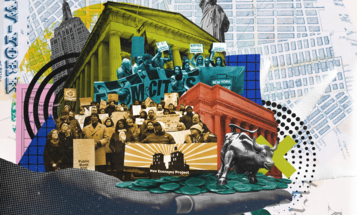
Financial Pipeline Series Pt. 1: Leaks in the Capital Intermediation Pipeline
Why it's as if there were a tax on the non-financial portions of the economy that redistributes wealth to the financial sector.
The financial sector provides a crucial function to society. It accommodates the movement of funds from investors to businesses, governments and individuals who use the capital for productive purposes. If the financial sector does this efficiently, the cost to the users of capital will be close to the price demanded by investors. The financial sector will have extracted amounts for providing the “capital intermediation pipeline” that are commensurate with the service provided.
If asked, most people would say that the cost of capital intermediation must have gone down in recent decades. After all, advances in technology and quantitative analysis must have made the process less expensive. But they have not. Capital intermediation is now more costly than it was in the days of James Pierpont Morgan.
My new research points out that capital intermediation costs have been rising since 1980, coincident with the beginning of three and a half decades of deregulation. At the same time, the financial sector share of both total income and GDP of the United States has risen sharply and ominously. If we assume the average financial sector share of the GDP over the 20 years prior to 1980 (4.2 percent) is a good baseline, the current financial sector share of GDP, 8.3 percent, exceeds the baseline by 4.1 percentage points.
This means that the amount of GDP represented by the financial sector is $635 billion higher each year than it would be based on its GDP share before the Great Deregulation Experiment began.
The important thing to keep in mind is that this is not simply a matter of traders grabbing money from other traders. Capital intermediation is the process through which the economy determines which productive activities, if any, will be implemented. It is how the supply of jobs for the American public is replenished and preserved. A broad and diverse supply of new jobs better assures that income and wealth will be fairly and evenly distributed. The public bears the cost of the value extracted by the financial sector by exploiting distortions in this critically important process, distortions that it often creates to generate higher profits.
In short, it's as if there were a tax on the non-financial portions of the economy that redistributes wealth to the financial sector.
This is critical to the public’s view of regulation. The concept of “burdensome regulation” suggests that rules to protect the public may be unavoidable, but they also diminish the inherent efficiency of unregulated industry. This is not true. Financial markets work efficiently when prices are transparent and fairly reflect fundamental value (that is to say value directly related to the reasonably anticipated net revenues of a government or business, adjusted for risk).
However, such an efficient marketplace would never involve the extraction of vast amounts for the service of providing capital intermediation. When assessing the costs and benefits of a regulation of the financial markets, one must consider the benefit of simply dampening the wealth transfer that burdens the unregulated system.
Opponents of reform make two points: first, burdens that reduce trading volume will destroy “trading market liquidity,” thereby increasing transaction costs and damaging the economy; second, that financial innovation will be stifled by burdensome regulations.
The research piece points out that these criticisms ignore that trading volume and market liquidity are two very different things.
High trading volume (many times, but not always) means that individual transaction costs are lowered by greater competition to do a deal. But high volume can also mean that trading strategies that involve a large number of transactions are being implemented to extract value from the capital intermediation system. Just because high volume reduces the transaction cost of a pension fund, for example, does not mean that the pension fund will achieve a better long-term result if the capital intermediation process is more efficient in an environment with lower trading volume.
The liquidity boogey man is worse than superficial; limiting volume, especially specific types of volume, is likely to benefit the economy massively and, in particular, institutional investors.
We then turn to the sacred cow of financial innovation. Financial innovation nowadays means that the banks concoct a financial “product” involving risks and costs that even a sophisticated chief finance officer—without the abilitiy to call on hundreds of in-house physicists and mathematicians like the banks can—cannot possibly comprehend. The CFO does understand that if he or she fails to buy the “product” touted as a risk management device by Goldman, JP Morgan and the like, and something goes wrong, his or her job will be at risk. Most often, the CFO has no chance at ascertaining the “price” for the “product,” but he or she does understand job security. This is no way to achieve efficient capital intermediation.
Subsequent articles will deal specifically with key elements of the modern financial markets: high-frequency trading, derivatives, exchange traded funds, commodity index funds, and biases of money managers, ratings agencies, governmental decision makers and corporate finance officers. These articles will show how the deed is perpetrated by the financial sector. But the scope of the problem and the key to discerning how much money is being extracted day in and day out is revealed in the first article, now available.



